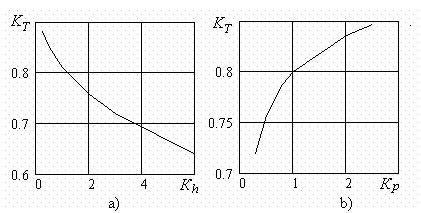
The thermal state of the cutting tool determines efficiency of his use to a great extent. The modern tendencies of intensification of the cutting modes during exploitation of the cutting tool result in the substantial increase of his thermal loadings that determines actuality of tasks on their research.
Presently the methods of researches of the thermal state of the cutting tool are well enough developed in the conditions of the set heat exchange [1, 2, 3]. However in a number of cases at the brief or irregular cutting ignoring non-stationaryness of process is impossible. General theoretic conformities to the law of description of the thermo physical phenomena are known at the unset heat exchange do not take into account the features of functioning of the cutting tool and require substantial clarification. There is of both scientific and practical interest research of possibilities of theoretical description of the thermal state of the cutting tool and estimation of their temperature under various conditions exploitations.
The purpose of the presented work is creation of method of calculation of temperature of the cutting tool in the conditions of the unset heat exchange and also analysis on its foundation of influence of treatment terms on his thermal state.
Pursuant to the method of warmth sources a decision is known differential equalization of heat-conducting for a point source continuous-action in unlimited space [1]:

where  - distance from any body point М(х, у, z) to the place of the point source flash J(хи, уи, zи); Q, t- temperature and time, w - coefficient of diffusivity; q- closeness of the thermal stream division; erf[u] - the known modified function to the integral of probability.
- distance from any body point М(х, у, z) to the place of the point source flash J(хи, уи, zи); Q, t- temperature and time, w - coefficient of diffusivity; q- closeness of the thermal stream division; erf[u] - the known modified function to the integral of probability.
During pasteurization of the technological system components the cutting tool blade is examined as an unlimited wedge with the corner of sharpening b. The warmth source which arises up on the front surface of the cutting tool blade appears rectangular with the sizes bхl (l is length of contact ground of shaving with the front surface of blade in direction of the shaving east, b is a width of contact ground).
The dimensionless temperature field which arises up in the blade of the cutting tool under the action of such source at the unset heat exchange is described as follows:

Most interest from point of the non-stationary cutting presents the fragmentary cutting which is characterized the presence of workings strokes by duration tp which alternate with idling duration th. Such processes a slope, milling, polishing circles, can exemplify with a irregular surface. In the period of working stroke there is heating of instrument which is described the analytical dependences resulted before. In the period of idling in absence of heating there is cooling of cuttings edges due to taking of heat from the area of cutting deepen blades. A cooling process in this case is described as follows:

Cyclic process of change of the blade top temperature at the fragmentary cutting has analytical description:



Calculations and construction of the graphs on fig.1 are executed applicably to treatment the cutting tool with the hard-alloy plates T15K6 (coefficient of diffusivity = 0,100*10-4 m2/с) for terms treatments which provide the sizes of contact ground of shaving with the front surface of blade l= 1mm, b = 2mm, duration of working stroke tp = 0,1с, single - th = 0,2с.

In the first cycle tc1 during the first working stroke tp1 there is sharp growth of temperature in accordance with to the curve of heating ТН1 and then during idling th1 - decline of temperature in accordance with to the curve of cooling ТО1. In the second cycle tc2 in the period of working stroke there is heating on the curve ТН2, in the period of idling - cooling on the curve ТО2. In the subsequent cycles tc heating and cooling repeat oneself. In some moment of time they are counterbalanced. The process can be considered permanent and characterized the middle temperature of Тср.
With the use of the noted method the calculations of coefficients of decline of level of temperatures are executed at the fragmentary cutting as compared to continuous КТ for different correlations of workings and single strokes the results of which are resulted on fig. 2.
The followings cases of cyclic treatment are considered:
- duration of working stroke permanent tp = const, the change of duration of idling is characterized the coefficient Кh = th / tp(fig.2 а);
- duration of idling permanent th = const, the change f duration of working stroke is characterized the coefficient Kр = tp / th (fig.2 b).

On the basis of the resulted graphs the quantitative estimation of efficiency of increase of duration of idling and diminishing of workers can be executed, that to leads substantial decline of level of temperature of t the cutting tool. The got results enable to forecast the change of temperature depending on correlations of workings and single strokes during the fragmentary cutting, and also to manage the decline of temperature due to the choice of rational level of these correlations.
With the use of method determination of dimensionless temperature can be executed analysis of temperature of t the cutting tool under various conditions exploitations on the basis of determination for these terms of size to the coefficient Р facilities of calculation of which are known enough [2, 3].
Thus with the use of method of warmth sources the method of analytical calculation of temperature of t the cutting tool is developed in the conditions of the non-stationary cutting that allows to forecast an instantaneous temperature in any point of blade of instrument during the fragmentary cutting. Analytical researches are executed on its foundation give the estimation of decline of temperature of instrument during the fragmentary cutting comparatively with continuous for the different terms of treatment.
The offered method can be widely used for prognostication of the thermal state of different the cutting tools in the conditions of the non-stationary cutting.
1. Резников А.Н., Резников Л.А. Тепловые процессы в технологических системах. - М.: Машиностроение, 1990. –288с.
2. Iвченко Т.Г. Аналітичне визначення температури різання в залежності від умов експлуатації ріжучого інструменту // Наукові праці Донецького національного технічного університету. Серія: Машинобудування і машинознавство. Випуск 92. - Донецьк, ДонНТУ, 2005.- С.37-42.
3. Tatjana Ivchenko. Research of thermal processes and control of temperature of cutting at exploitation of a modular cutting tool // PROCEEDINGS OF THE 4-TH INTERNATIONAL CONFERENCE ON ADVANCED MANUFACTURING TECHNOLOGIES ICAMAT. Bucuresti: Editura Academiel Romane; 2005. – P. 507-512.